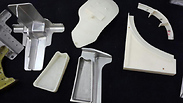
Parts printed by the 3D printer
צילום: יואב זיתון
The 3D printer revolution comes to the IAF
New 3D printer can manufacture spare parts for fighter jets within hours, while a new American robot can do a job that takes five soldiers four days to do - in one night.
An international breakthrough in the aviation world will land in Israel in less than a month when the Israel Air Force receives a 3D printer that can manufacture spare parts for fighter jets and Israeli helicopters.
The printer, acquired from an American company for hundreds of thousands of dollars, has already been tested in secret over the past few months, printing a part for the Israeli Eitan drone, the largest of the IAF's unmanned aerial vehicles (UAV).
At first, the printer will print relatively small components out of polymer, which is considered a high-quality plastic material, as part of a pilot, and at a later stage, it will also print metal parts. In the first stage, the printer will only be able to print parts that are no bigger than one meter in length.
"We've conducted experiments on the ground with the parts that were printed and installed onto the planes, and it was successful," a senior IAF officer told Ynet. "We also got engine parts that were printed, and in the 3D era we could, in the future, print generators for planes, bearings or a full engine for an aircraft, with the pistons already inside. The vision is, of course, to print an entire plane."
According to the officer, the IAF plans to utilize the printer for fast manufacturing of parts such as air ducts for the plane.
The American Air Force already started working with 3D printers, but according to the IAF officer "they too are still only in initial stages."
The British Royal Air Force made history six months ago when a Tornado fighter jet took off with printed replacement parts.
Now, the Israeli Air Force will become one of the few Western armies bringing the 3D revolution into its airbases for the maintenance of airplanes.
"This move will quickly return the investment," the IAF officer told Ynet. "The main advantage of the printer is that you are no longer limited in geometry. For example, when you want to create a space inside a block of aluminum or a ring inside a ring. In addition, we will no longer need to keep storerooms full of spare parts. Missing a part? Print it within hours."
Meanwhile, the Air Force's air maintenance unit, in which engineers serve alongside dozens of technicians, will soon receive an American robot that can disassemble and reassemble screws from airplanes. The robot can independently disassemble, among other things, wing covers of fighter jets.
This will significantly reduce the manpower needed for the maintenance unit. At present, a team of five soldiers manually disassembles the 3,000 screws attached to the plane's wings in four days, and a similar procedure recurs when the screws are put back on. The new robot can disassemble the thousands of screws in one night, saving invaluable time.
"The next stage will be to purchase a robot that can remove paint from planes, during maintenance work to renew the paint," officials in the IAF said.











